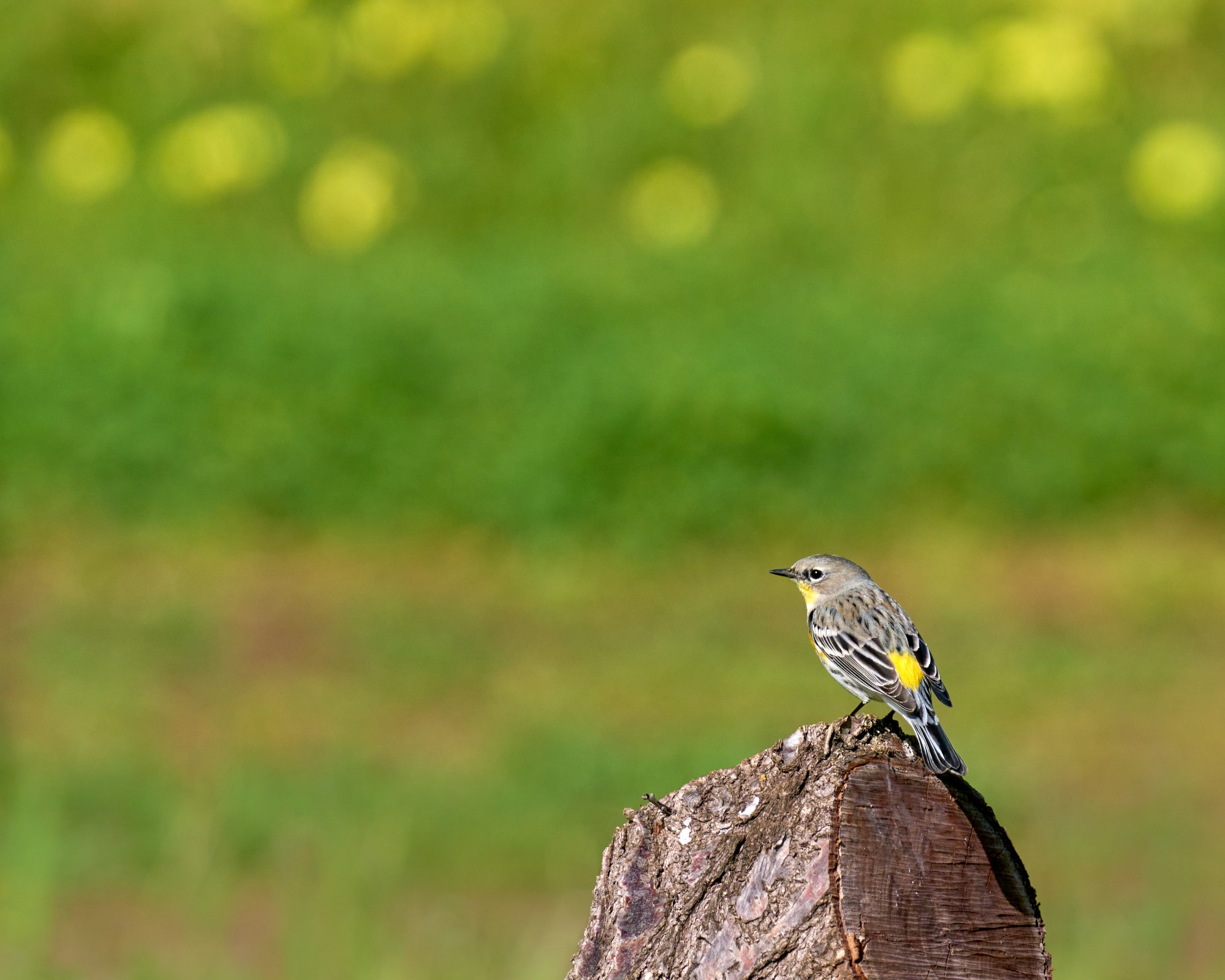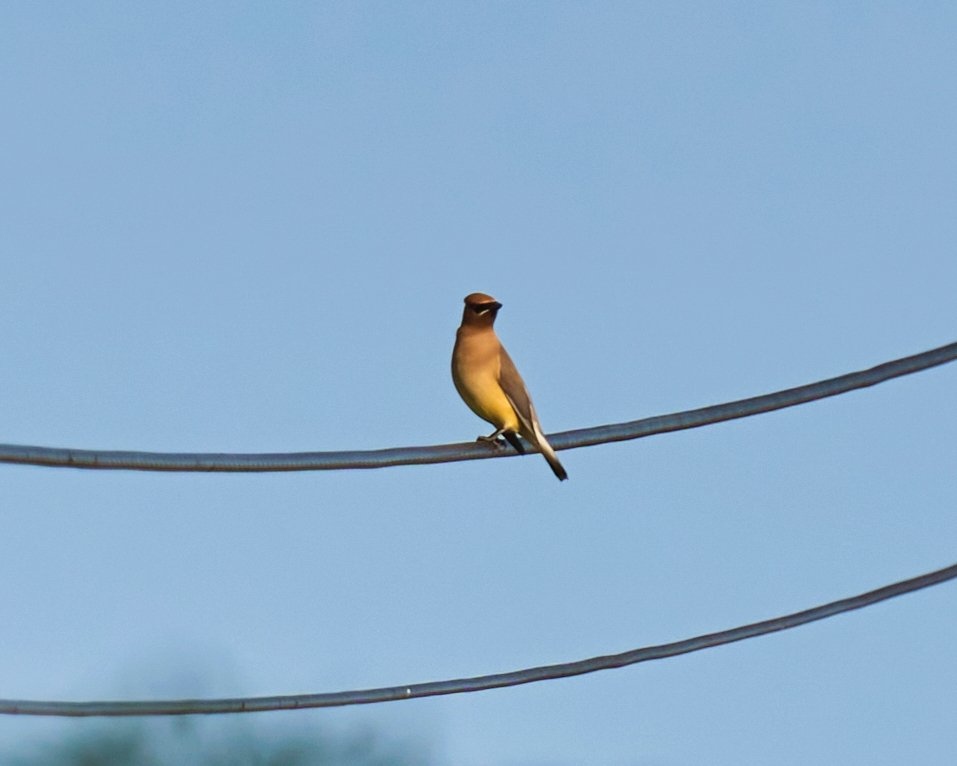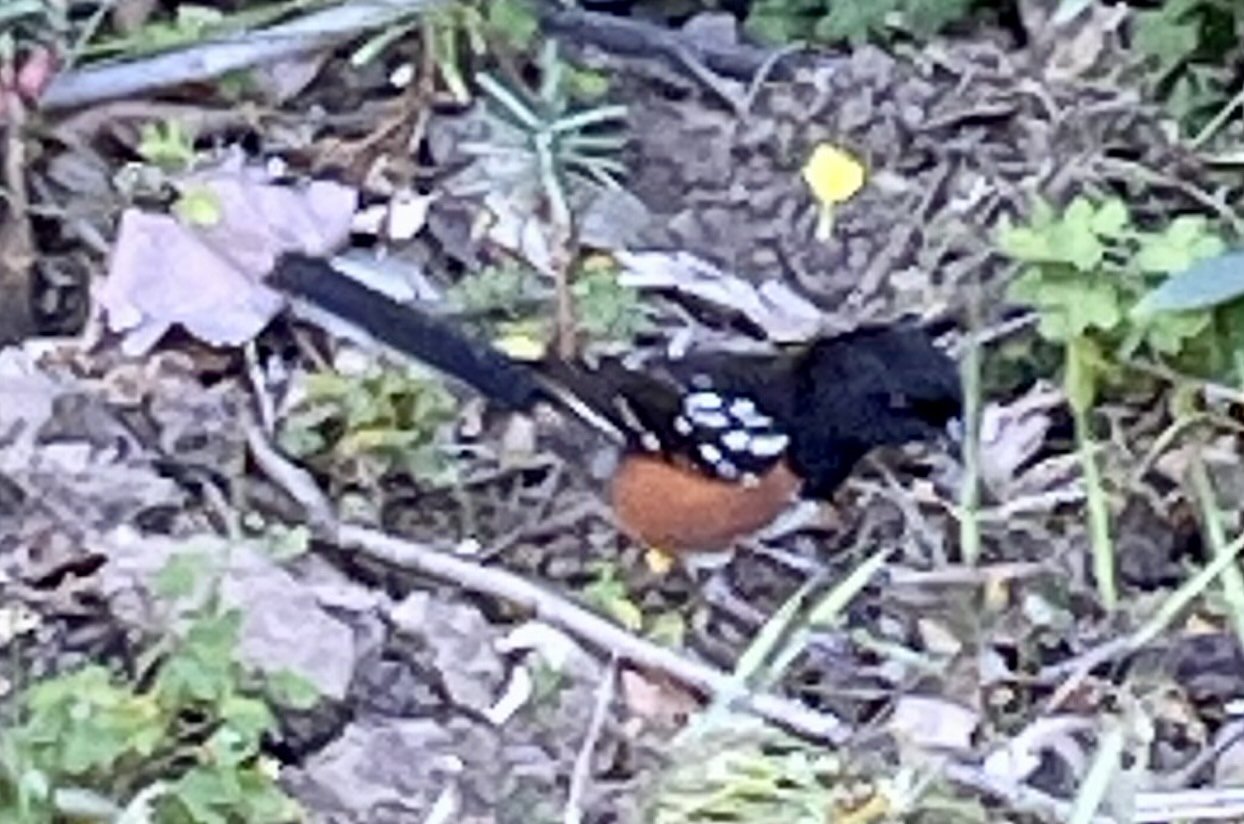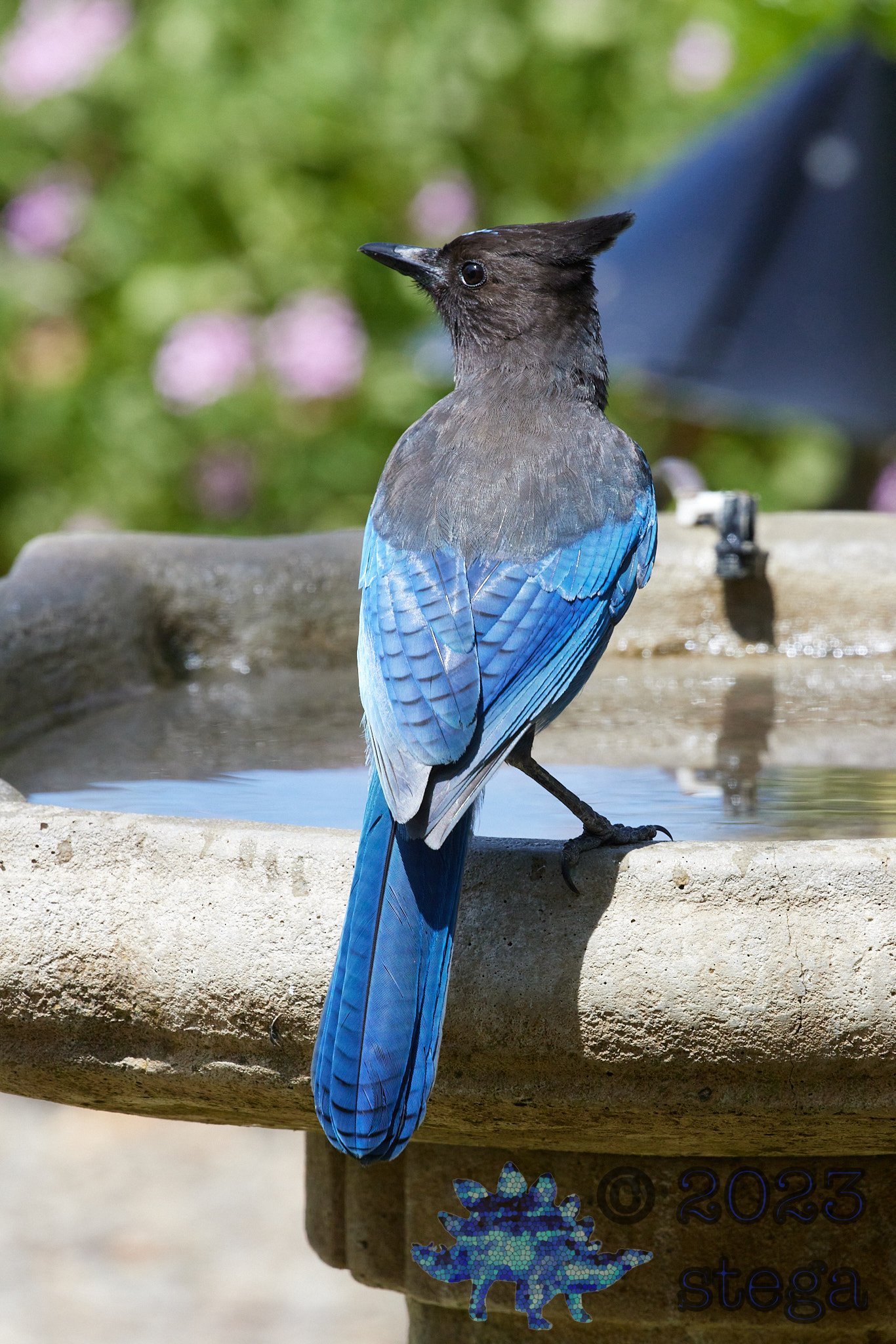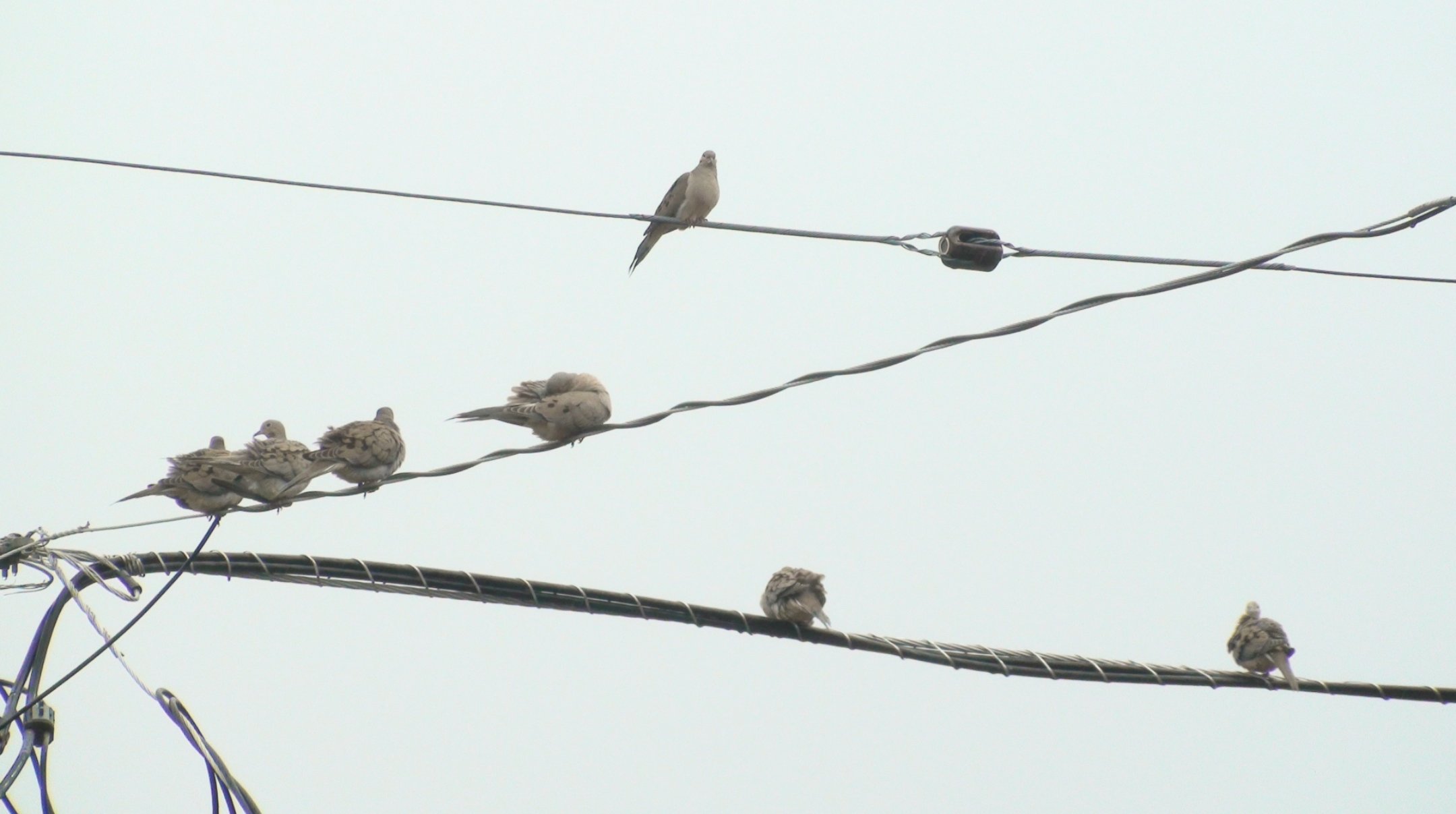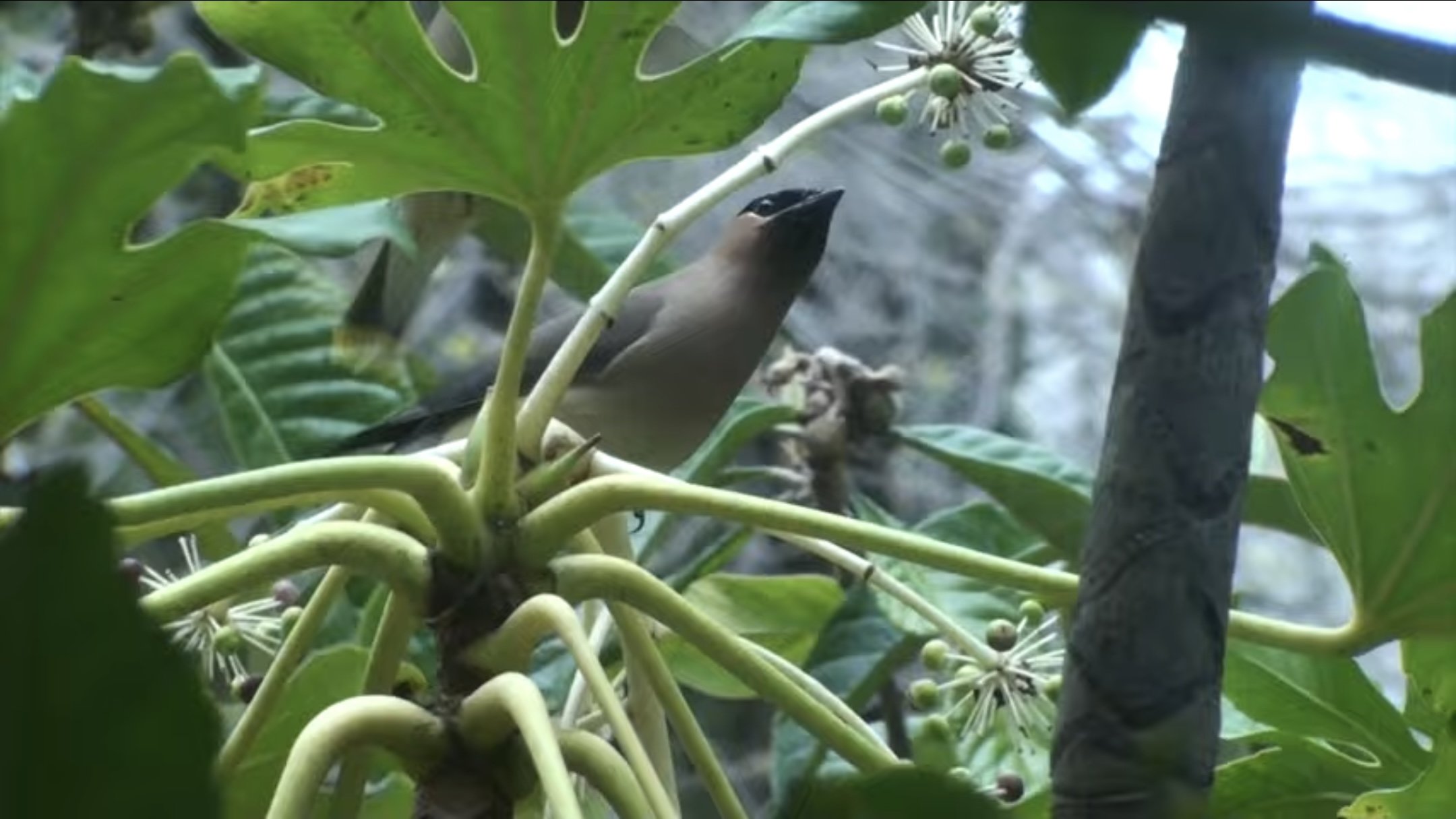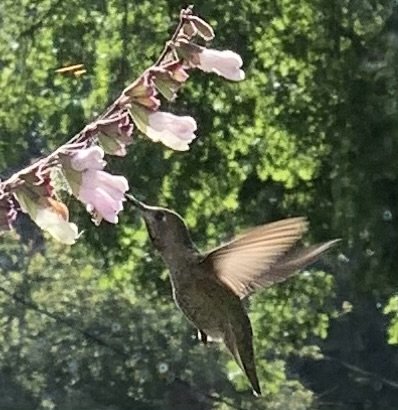All Around Town
BACKYARD BIRD OBSERVATIONS FROM OUR MEMBERS AND FRIENDS
Spring is here, and it’s still raining! Despite the very wet winter, our backyard birds still relish the water, and those of you with bird baths have had regular visitors in the past couple of months. Thanks to all of the rain, puddles and ponds suddenly and dramatically appeared in the landscape, and you observed birds using these natural sources of water too.
March and April are a time of transition, when our winter resident birds start to leave for their nesting grounds elsewhere, and our summer residents begin to arrive, establish territories, and nest.
You noticed the departure of White-crowned Sparrows and Golden-crowned Sparrows, some already in breeding plumage, as well as Yellow-rumped Warblers, also boldly colored for the springtime. A wintering Merlin departed, and the Hermit Thrushes that visited some of your yards in earlier months are also on their way out of town.
At the same time, other birds are arriving. Some of you saw your first Hooded Orioles of the season, and are hoping to attract them to your yards with special oriole feeders - these birds love oranges and sugar water (see the “Backyard Tips” here). Black-headed Grosbeaks, also spring arrivals, were spotted at one contributor’s feeders.
And of course, all of the birds that breed here - summer and year-round residents alike - are building nests, incubating eggs, and raising their young. You’ve reported nests of Anna’s Hummingbirds and Oak Titmice in your yards, and noticed swallows and swifts nesting on highway overpasses. You’ve spotted Red-shouldered Hawks in pairs, and a Cooper’s Hawk near a former nesting spot.
If we had to pick one bird as the mascot of March and April, this year it would be the Cedar Waxwing! Your reports of these birds usually peak in midwinter, but this year, many of you reported sightings of them in the early spring. You’ll find delightful observations and pictures of them below.
For more about Cedar Waxwings, take a look at our special All Around Town feature about the birds (scroll down to the end of the blog post), and read our guide to the species in our Backyard Bird Grid.
Here are your backyard bird observations from the months of March and April:
In March, Steven Rice (Palo Alto) paid a visit to “the well-read, cultured, and law-abiding denizens of the Los Altos Civic Center complex. Some of the regulars and a couple of new birds were there, for both formal portraits and candid lifestyle photos.”
Here are some of Steven’s photos from his shoot:
An American Crow bathes in a pool of water after a storm.
A Bewick’s Wren perches on a branch, bill slightly open, as if it has something to say.
A Yellow-rumped Warbler shows off its yellow markings, with matching flowers in the background.
Lesser Goldfinches, with one Yellow-rumped Warbler in the bottom right corner
Steven writes: ““Here are four finches, with one sad little warbler wishing it could join the party.”
In April, Steven returned to the Los Altos Library, where he found this White-crowned Sparrow (above).
One of the many waxwings spotted by Steven
At the end of April, he sent this update: “I couldn’t know there were Cedar Waxwings in the area without getting some photos. They’ve been swooping and perching en masse near my building.”
Cedar Waxwings in Joseph’s neighborhood
Towards the end of April, Joseph Ribera (Sunnyvale) wrote: “In the neighborhood this week, all the usual suspects: Dark-eyed Junco, House Finch, Western Bluebird, Northern Mockingbird, Mourning Doves, American Crows and the first Cedar Waxwings.”
A Cedar Waxwing observed from Kiri’s backyard. Note the bird’s red “waxy” wingtips and bright lemon-colored tail stripe.
Kiri Picone (Morgan Hill) writes: “On March 15, I noticed a flock of birds in the tree that hangs into our backyard. I believe they were Cedar Waxwings. My kids and I watched for a while as they ate every single berry off the tree (and the ground!), leaving behind a huge mess of droppings for us to clean up.”
The Western Bluebird spotted by Yathir and his father at McClellan Ranch in Cupertino. This brightly-colored bird is a male. Females are a more muted blue-gray and orange-red.
Yathir Iyengar wrote to us at the end of April: “I am in fourth grade and am learning about birding. My dad and I saw this Western Bluebird and Spotted Towhee at McClellan Ranch this past weekend. It was wonderful to see them!”
The Spotted Towhee observed by Yathir
The Merlin that has wintered in Airdrie’s neighborhood for the past three years
Airdrie Kincaid (Santa Clara) says: “The cloudy first day of spring was when we last spotted the Merlin that has visited a neighborhood sycamore tree for the past three winters. One of my projects this year has been to see how many bird species I could photograph perched on that tree. The answer was thirteen, but the only bird up there recently has been a big crow.”
A Black Phoebe fans its tail in Airdrie’s persimmon tree. These birds fan their tails when stretching, although we don’t know exactly what the bird pictured here is doing.
She adds: “Two Black Phoebes have been busy catching insects in the backyard. Although lots of birds perch on our old persimmon tree, they’re harder to see now that the leaves have opened.”
Cedar Waxwings visit Deanne’s bird bath. Note the small red spikes on the tips of the wing feathers of the bird flying in. These spikes are the feathers that make up the red “wax” drops you see when the bird is at rest!
Deanne Tucker (Los Altos) writes: “We had another Anna's Hummingbird nest outside our kitchen window, which was a joy to observe. Our new fountain is attracting birds including a Hermit Thrush, doves, Cedar Waxwings (who come for our ivy berries as well), American Robins, and others. They, in turn, have attracted a pair of Red-shouldered Hawks and a Cooper's Hawk.”
Deanne photographed the hummingbird nestlings through the time that they fledged.
She writes: “The Anna's Hummingbird built her nest in the middle of February. Around March 11, we saw the babies poke their bald heads up for the first time. Around March 23, they had some feathers on their heads, and by the end of March they looked like small hummingbirds and were outgrowing the nest.”
Here are some of Deanne’s photos of the nestlings and their mother:
Female Anna’s Hummingbirds build nests, incubate eggs, and raise their young on their own.
Deanne continues: “At the beginning of April we saw the nestlings starting to flap their wings. The first one left on April 2, with the second one leaving a couple of days later.”
The pictures below show one of the nestlings testing its wings (do you notice how short the wings and tail are?) as it prepares to leave, and then finally, it’s out of the nest!
Baby birds often have short wings and tails. As they grow, they will eventually develop the longer wings and tails of adult birds.
Eve Meier (San Jose) says: “I'm always watching for birds as I go about my errands. This month I'm enjoying the Northern Rough-winged Swallows that nest under an overpass. They are often darting about as I'm waiting to get on the freeway. And, as I pass through a different interchange, I like to watch the White-throated Swifts circling overhead. They nest in the joints of the overpass.”
A female Hooded Oriole visits Jennifer’s oriole feeder. Female Hooded Orioles lack the swatch of dark feathers that the males have on their throats and faces.
Jennifer Oliver (San Jose) writes: “In March and April we've seen a couple of new birds to our yard. We had only our second-ever Downy Woodpecker and my first Hooded Oriole (female).”
A female Downy Woodpecker in Jennifer’s oak tree. Females have black and white stripes on top of their heads; males have a red spot, in addition to these stripes, on their heads.
“Also, we had two nests built in our backyard this year - Oak Titmice and Bewick's Wrens. Unfortunately the Bewick's Wrens both completed the nest, but then never ‘moved in.’ I still see them at the suet feeder most days, so they must be nesting nearby. I'm hoping I might see their fledglings soon.”
Oak Titmouse eggs in Jennifer’s nest box. Nine is a lot!
“As for the Oak Titmouse nest, we amazingly have nine (!!) hatchlings this year! I don't know how the mama and papa bird feed all those hungry mouths! Here are a couple of photos we quickly snapped during our nest box checks.”
Jennifer thinks the nestlings will have fledged by early May.
Oak Titmouse nestlings, eager to be fed!
She adds: “I mentioned last year that one of the Oak Titmice we had nesting was missing a toe, and I was hopeful we would see that bird again. However, neither of the Oak Titmice nesting in our box this year is the same bird. We were wondering if maybe it could also be one of last year's fledglings? Either way, we can't wait to see them flying around our backyard oak tree soon!”
Ryan Ludman (San Jose) writes: “In March, I was happy to see twenty-one different species in my yard. New this month were a flock of Bushtits in a neighboring cypress tree. A Cooper’s Hawk visited my feeders regularly through the month without success until the last day of March when it caught a House Finch. Also, on March 31, a flock of Cedar Waxwings visited my yard.”
“When I get home from work I put out more mealworms and within seconds, before I leave the patio, a Northern Mockingbird is snacking away. I’ve enjoyed watching Yellow-rumped Warblers transition to breeding plumage over the month as they enjoy mealworms and grape jelly. In the front yard a male Western Bluebird has been hanging out on the power line and in the mulberry tree. A Black Phoebe appeared on the side-view mirror of a nearby truck and didn’t seem to mind the rain at all.”
Here are the species that Ryan observed in his yard in March:
Mourning Dove
Anna’s Hummingbird
Cooper’s Hawk
Black Phoebe
American Crow
Chestnut-backed Chickadee
Bushtit
White-breasted Nuthatch
Bewick’s Wren
European Starling
Northern Mockingbird
Western Bluebird
American Robin
Cedar Waxwing
House Finch
Lesser Goldfinch
Dark-eyed Junco
White-crowned Sparrow
Golden-crowned Sparrow
California Towhee
Yellow-rumped Warbler (Myrtle & Audubon’s subspecies)
Two male Black-headed Grosbeaks visit LC’s feeders.
LC Boros (San Jose) reflected on the month of April: “I thought spring would have finally arrived but it seems that was not the case. Things have been very subdued. While the Black-headed Grosbeaks and orioles have arrived, our jays have been far less combative than in past years. The California Scrub-Jays have again given way to the Steller’s Jays for dominance of the north garden area - probably because the latter easily outweigh the former. I’m not kidding, our pair of Steller’s are almost half-again the size of our Scrubs.”
A Steller’s Jay visits LC’s bird bath.
“It’s not just dueling jays this year, we also have two pairs of Northern Mockingbirds, but they seem to have reached a detente and are content patrolling opposite sides of the house yard. I’ve also caught sight of several wrens (both Bewick’s Wren and House Wren) and late in the month our first fledgling California Thrasher popped up onto one of the garden baths.”
A California Thrasher fledgling at one of LC’s bird baths. Note its loose, scruffy feathers, and shorter decurved bill compared to an adult’s.
“In addition to the usual suspects we have at least one Spotted Towhee flitting about and the old barn is again stocked with swallows, which makes our phoebes and other flycatchers a bit grumpy. Our herd of California Quail are also slightly annoyed by the arrival of a few Wild Turkeys — one of which decided to both defecate and lay an egg in one of the baths this past weekend.”
A Wild Turkey laid this egg in one of LC’s bird baths.
LC adds: “Finally, all of the winter rains means the tall grasses are in and we started mowing our fire breaks this month. Our resident Red-tailed Hawks seem to appreciate the work as one of them is seemingly always perched on an old mast pole scanning the old rodeo ring in the south pasture for prey.”
A Red-tailed Hawk, wet from the rains, keeps an eye on LC’s pasture.
Curt Bianchi (Saratoga) says: “We had a nice variety of birds in our yard this winter and continuing well into April. I especially enjoyed the Hermit Thrushes and Yellow-rumped Warblers. In addition to coming to our suet feeders, they were regulars at our backyard bird bath.”
A Hermit Thrush visits Curt’s yard.
“Lately, though, things have been pretty slow. The most regular visitors to the bird bath of late have been Mourning Doves [see Curt’s video below], which show up several times a day. We also have a California Scrub-Jay who stops by often. Being year-round residents, I suppose these are not the most exciting of visitors.”
“That may change because at the end of April I saw a pair of Hooded Orioles on back-to-back days in our coast live oak tree. That got me motivated to reactivate our oriole feeders. I put one in the front yard hanging from the oak, and one in the backyard. However, the wind knocked off the one in front and broke it. Boo! Anyway, I am hoping the orioles show up at the bird bath one of these days. I got a couple of Bullock’s Orioles there last June. We’ll see!”
Some of the Mourning Doves that hunkered down on the power lines near Anjali’s home during the rain.
Anjali Mallya (Cupertino) writes: “The storms and rains this year gave me opportunities to stay home and observe birds for extended periods of time. One rainy day in March I had some Mourning Doves sitting on the power lines. It was interesting to see they didn’t move from the place and literally sat there for more than two hours. I observed them from 10:30 onwards. And they left at 1 pm. There were twelve of them.”
“Mourning Doves are great subjects for close-up photography as they literally just sit there for an extended time. I was amazed to see how they blink and close their eyelids.” In Anjali’s video above, notice the dove’s turquoise eyelids when it blinks!
A Cedar Waxwing in Anjali’s yard
“The most exciting backyard birding moment was when a flock of Cedar Waxwings came to eat some berries. I have seen them before but they always fly away in an instant. But this visit they stayed long enough to eat all of the berries and I had enough time to take their pictures.”
“I have been exploring my new camera and zooming in on birds is my latest pastime. This is the first time I have been able to observe Dark-eyed Juncos so closely. They are super cute and fluffy. I like their song” [which you can hear in Anjali’s video above].
“A new backyard visitor I saw and ID’d was the Bewick’s Wren. I was very excited to see it for the first time. I liked observing it foraging not only on the ground but also hopping on the fence sideways.”
Anjali adds: “One evening a little Northern Mockingbird and I had some close eye-to-eye interaction. The camellia flowers are in full bloom. It’s beautiful.”
Jack Tomlin (Los Altos) wrote on March 11: “I think I have a pair of Oak Titmice occupying a nest. I don’t know if it is early. Maybe it’s ‘the early bird gets the nest.’ I saw them first yesterday and thought it might just be exploratory, but this morning the two of them are as busy as bees going in and out and a lot of tapping noise from inside.”
He adds: “I also saw yesterday a Cooper’s Hawk in my yard, and again this morning. Cooper’s have been building nests for quite a few years now somewhere very near. In the past I have several times seen newly fledged birds on my fence. I have never actually seen a nest, though once I am sure it was hidden behind some oak foliage. One time I watched a hawk sitting for several hours on a limb close to my nest guess. I would go out to look and it would still be in the same place.”
Jack Cole (San Jose) reports that he did not see Western Bluebirds in his yard in March. Until then, Jack had bluebirds visiting his yard every month for over one year.
Emma writes: “An annoyed and confused Yellow-rumped Warbler looking at me accusingly after the trees came down.”
Emma Shelton (Menlo Park) says: “March was so cold, and so wet. Ugh. There was even snow at not-so-high elevations. All the downed trees, noise of chain saws and chippers every day must be confusing for the birds.”
“Our permanent residents it would appear are still a couple of Anna’s Hummingbirds, Mourning Doves, California Scrub-Jays, American Crows, Chestnut-backed Chickadees, Oak Titmice, White-breasted Nuthatches, Pygmy Nuthatches, Dark-eyed Juncos, and a few Bewick’s Wrens. None of them seemed to mind the weather and enjoyed the feeders. The Lesser Goldfinches and House Finches remain very numerous!”
“The Downy Woodpeckers and Nuttall’s Woodpeckers still come to the feeders, although they are also evident by the drumming in the few large old oaks nearby.”
“In early March through early April we had a few Bushtit parties come through, one time during pouring rain! Why do I know this? I was out looking. Good grief!”
“The Golden-crowned Sparrows and White-crowned Sparrows remained very plentiful through March, and seemed to be loading up on grub from under the feeders for several days. Then on April 21 - GONE! As quickly as they showed up in the first place. Amazing. I was surprised at how long they stayed.”
“In early April we had a Great Blue Heron fly over on a Friday late afternoon, which was quite a thrill!”
“A few weeks ago we started seeing flocks of swallows again, flying around a nearby palm tree and hanging out on telephone wires in the late afternoon. Pretty sure they are Violet-green Swallows, in bunches of a dozen or so.”
Emma writes: “Our resident Anna’s Hummingbird going after the salvia ‘Waverly’ flowers outside the front window.”
Here are some of the other birds observed by Emma in her neighborhood:
Cooper’s Hawk
Red-shouldered Hawk - We have a lot of tall trees in our area for perching and spying on unsuspecting rodents.
American Robin
Cedar Waxwing
Fox Sparrow - Two were in the backyard until March 11, then left.
California Towhee
Spotted Towhee - The racket starts at dawn outside the bedroom window.
Yellow-rumped Warbler - A few in the backyard in March and early April. On April 2, we saw the last of them for the season.
A Golden-crowned Sparrow in Linden’s neighborhood. The bird looks to be in breeding plumage, with a bright yellow crown. Golden-crowned Sparrows migrate north to their nesting grounds in the spring, but often develop their breeding plumage before leaving.
Linden Skjeie (San Jose) shared some of her recent photos with us.
A Spotted Towhee at the top of a tree. These birds will often sit on a high perch, throw back their heads, and sing.
A pair of Red-shouldered Hawks blends into the foliage, seemingly in “camouflage,” as Linden notes.
An Anna’s Hummingbird nest above Linden’s back deck. This photo was taken on April 1, and the nestlings fledged later in April.
Happy backyard birding in May, everyone!
Bird species reported to All Around Town from October 2020 onwards
Greater White-fronted Goose
Canada Goose
Mallard
Bufflehead
Hooded Merganser
California Quail
Wild Turkey
Indian Peafowl (feral)
Rock Pigeon
Band-tailed Pigeon
Eurasian Collared-Dove
Mourning Dove
Vaux’s Swift
White-throated Swift
Anna’s Hummingbird
Rufous Hummingbird
Allen’s Hummingbird
Killdeer
Long-billed Curlew
California Gull
Double-crested Cormorant
Great Blue Heron
Great Egret
Snowy Egret
Black-crowned Night-Heron
Turkey Vulture
White-tailed Kite
Golden Eagle
Northern Harrier
Sharp-shinned Hawk
Cooper’s Hawk
Bald Eagle
Red-shouldered Hawk
Red-tailed Hawk
Ferruginous Hawk
Barn Owl
Western Screech-Owl
Great Horned Owl
Belted Kingfisher
Red-breasted Sapsucker
Acorn Woodpecker
Downy Woodpecker
Nuttall’s Woodpecker
Hairy Woodpecker
Pileated Woodpecker
Northern Flicker
American Kestrel
Merlin
Olive-sided Flycatcher
Western Wood-Pewee
Pacific-slope Flycatcher
Black Phoebe
Say’s Phoebe
Western Kingbird
Hutton’s Vireo
Cassin’s Vireo
Warbling Vireo
Steller’s Jay
California Scrub-Jay
Yellow-billed Magpie
American Crow
Common Raven
Chestnut-backed Chickadee
Oak Titmouse
Northern Rough-winged Swallow
Tree Swallow
Violet-green Swallow
Barn Swallow
Bushtit
Wrentit
Ruby-crowned Kinglet
Red-breasted Nuthatch
White-breasted Nuthatch
Pygmy Nuthatch
Brown Creeper
House Wren
Bewick’s Wren
European Starling
California Thrasher
Northern Mockingbird
Western Bluebird
Varied Thrush
Hermit Thrush
American Robin
Cedar Waxwing
Scaly-breasted Munia
House Sparrow
House Finch
Purple Finch
Pine Siskin
Lesser Goldfinch
Lawrence’s Goldfinch
American Goldfinch
Chipping Sparrow
Fox Sparrow
Dark-eyed Junco
White-crowned Sparrow
Golden-crowned Sparrow
White-throated Sparrow
Savannah Sparrow
Song Sparrow
Lincoln’s Sparrow
California Towhee
Spotted Towhee
Western Meadowlark
Hooded Oriole
Bullock’s Oriole
Red-winged Blackbird
Brown-headed Cowbird
Brewer’s Blackbird
Orange-crowned Warbler
Yellow Warbler
Yellow-rumped Warbler
Black-throated Gray Warbler
Townsend’s Warbler
Canada Warbler
Wilson’s Warbler
Western Tanager
Black-headed Grosbeak
Lazuli Bunting
Hybrid ducks, domestic ducks, unidentified gull species, and Rufous/Allen’s Hummingbirds have also been reported to All Around Town.
References
All About Birds website, www.allaboutbirds.org. Cornell Lab of Ornithology, Ithaca, NY, USA.
Birds of the World. Edited by S. M. Billerman, B. K. Keeney, P. G. Rodewald, and T. S. Schulenberg. Cornell Laboratory of Ornithology, Ithaca, NY, USA. https://birdsoftheworld.org/bow/home
eBird: An online database of bird distribution and abundance [web application]. eBird, Cornell Lab of Ornithology, Ithaca, NY, USA. http://www.ebird.org
All Around Town is compiled by SCVAS Member Julie Amato.
Banner Photo: Hooded Oriole by Jennifer Oliver




